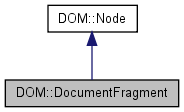KHTML
DOM::DocumentFragment Class Reference
DocumentFragment is a "lightweight" or "minimal" Document object.
More...
#include <dom_doc.h>

Public Member Functions | |
| DocumentFragment (const Node &other) | |
| DocumentFragment (const DocumentFragment &other) | |
| DocumentFragment () | |
| DocumentFragment & | operator= (const DocumentFragment &other) |
| DocumentFragment & | operator= (const Node &other) |
| ~DocumentFragment () | |
Protected Member Functions | |
| DocumentFragment (DocumentFragmentImpl *i) | |
Detailed Description
DocumentFragment is a "lightweight" or "minimal" Document object.
It is very common to want to be able to extract a portion of a document's tree or to create a new fragment of a document. Imagine implementing a user command like cut or rearranging a document by moving fragments around. It is desirable to have an object which can hold such fragments and it is quite natural to use a Node for this purpose. While it is true that a Document object could fulfil this role, a Document object can potentially be a heavyweight object, depending on the underlying implementation. What is really needed for this is a very lightweight object. DocumentFragment is such an object.
Furthermore, various operations -- such as inserting nodes as children of another Node -- may take DocumentFragment objects as arguments; this results in all the child nodes of the DocumentFragment being moved to the child list of this node.
The children of a DocumentFragment node are zero or more nodes representing the tops of any sub-trees defining the structure of the document. DocumentFragment nodes do not need to be well-formed XML documents (although they do need to follow the rules imposed upon well-formed XML parsed entities, which can have multiple top nodes). For example, a DocumentFragment might have only one child and that child node could be a Text node. Such a structure model represents neither an HTML document nor a well-formed XML document.
When a DocumentFragment is inserted into a Document (or indeed any other Node that may take children) the children of the DocumentFragment and not the DocumentFragment itself are inserted into the Node . This makes the DocumentFragment very useful when the user wishes to create nodes that are siblings; the DocumentFragment acts as the parent of these nodes so that the user can use the standard methods from the Node interface, such as insertBefore() and appendChild() .
Definition at line 991 of file dom_doc.h.
Constructor & Destructor Documentation
| DOM::DocumentFragment::DocumentFragment | ( | ) |
Definition at line 560 of file dom_doc.cpp.
| DOM::DocumentFragment::DocumentFragment | ( | const DocumentFragment & | other | ) |
Definition at line 564 of file dom_doc.cpp.
| DOM::DocumentFragment::DocumentFragment | ( | const Node & | other | ) | [inline] |
| DOM::DocumentFragment::~DocumentFragment | ( | ) |
Definition at line 588 of file dom_doc.cpp.
| DOM::DocumentFragment::DocumentFragment | ( | DocumentFragmentImpl * | i | ) | [protected] |
Definition at line 592 of file dom_doc.cpp.
Member Function Documentation
| DocumentFragment & DOM::DocumentFragment::operator= | ( | const DocumentFragment & | other | ) |
Definition at line 582 of file dom_doc.cpp.
| DocumentFragment & DOM::DocumentFragment::operator= | ( | const Node & | other | ) |
The documentation for this class was generated from the following files:
 KDE 3.5 API Reference
KDE 3.5 API Reference